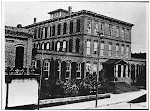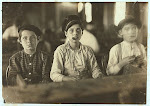Doing family history is a challenge, Cuban or not, but that’s the fun of it. Sometimes to find your direct line ancestor, you may have to go sideways (siblings, cousins, etc.) and down (descendents), and all around, rather than just back. Going sideways or down in research is a valid research method, and in a Latino ancestry is also relevant, because in the Latino community family includes almost everyone tied to your family in anyway.
One day I was talking to a cousin (whose mother is the daughter of the only child of my grandfather and his second wife, Guillermina). I’m related to his first wife, Pastora. My cousin told me that our cousin had died. When she told me who he was, I didn’t recognize his name at all. After some research I discovered that our cousin was the son, of the daughter of the daughter, from Guillermina’s first marriage. In spite of the fact I share no common ancestor with him, he is “our” cousin. Anyway I’m happy to claim him, because what I read about him in an article in Cigar Magazine, he was a person with many admirable qualities and abilities.
For the Cuban genealogists, the challenge will be to determine the actual relationship of all these “family” members, but in the process you may also find your direct line relatives. And remember these non-direct lines are usually the people your direct line relatives associated with, because they were family in some way. Searching this way is how I discovered my great-great grandmother, Dolores, and the mystery woman, Amparo that appeared on my grandmother’s delayed birth record. Amparo turned out to Dolores’ daughter from a first marriage.
That was also how I recently connected to another “cousin”, Linda. Our common ancestor is Dolores. Linda is related to Amparo. I’m related to Dolores’ daughter, Mercedes from a second marriage. From what I could work out on the relationship chart at http://www.islandregister.com/cousin.html, we are 3rd cousins one time removed. I think. Anyway, the point is that Linda knew the first name of my maternal great-grandfather, who she is not directly related to. Something I did not know, or anyone in the family I talked to.
Once I knew who Dolores was, and her maiden name, and suspected name of her second husband, Tomas, I could search in Family Search, Pilot record search, which indexes everyone in the records. Using Dolores with her maiden name I found her daughter, Mercedes. It listed her father as Tomas, which matched the information Linda gave me. If I hadn’t researched Dolores’ first marriage family, I wouldn’t have found my grandmother’s death certificate. Both my aunt and I had been searching over a period of twenty years, but until I searched sideways and down and all around, I never had the information to find her and be able to recognize that it was her, because the last name on the death index was misspelled so badly, I couldn’t search by that, and I didn’t know the names of her parents to know this Mercedes was mine.
Are you totally confused by my sideways and down and all around journey?
Well, here’s a source for you that is simple. Go to www.FamilySearch.org and click on the Search Record tab on the left, go to Record Search Pilot, then under the discover your ancestors option is a link that says browse our collections, click on it and you will be taken to a page that gives you three options, click on the map, or click on down area to identify the record area you are interested in or click on browse collection, which you may want to do just to see what they have.
Under the United States you will find:
Florida Deaths 1879-1939 (index, no images of records) What is neat about this index is that it indexes everyone as I said, so if you can’t find the person, and know the name of the parents, try those. You should search by the parents’ names as well, even if you do find the person under their name, because you may find siblings of your relative you didn’t know about.
Florida State Census 1935 and 1945. (index and images of records). This is a real bonus because U.S. Censuses are only available through 1930.
If you find someone in the Florida Death index at this site, you can go to the www.familysearch.org, library catalog, place--Florida, vital records, deaths 1879-1939, click on the “view film notes” button on the top right, and find the microfilm number for the film that the record would be in…or go to:
By going to any LDS family history center near you, you can have the film sent to you for a small fee, and if you are lucky, there may be more than one relative on the same roll of film.
Here’s where you find a family history center near you. On the www.familysearch.org site, under the library tab is a find a family history center near you option, fill in the information, click, and there you are, or go to: http://www.familysearch.org/Eng/library/FHC/frameset_FHC.asp.
Well, enjoy the roller coast ride-sideways, down, and all around, and check out the Florida sources at familysearch.org, if it’s the right time period.
Patricia







1 comment:
Very interesting. Look forward to watching your blog.
Post a Comment